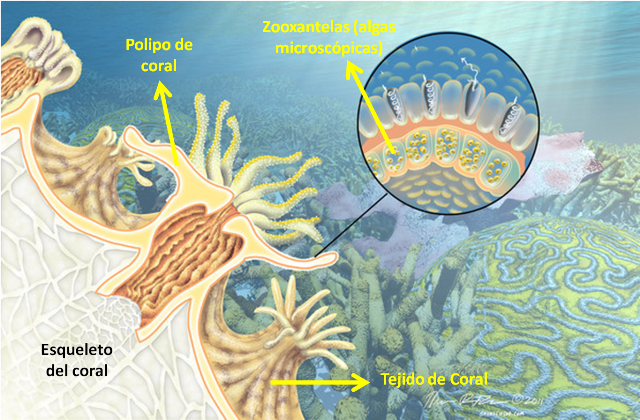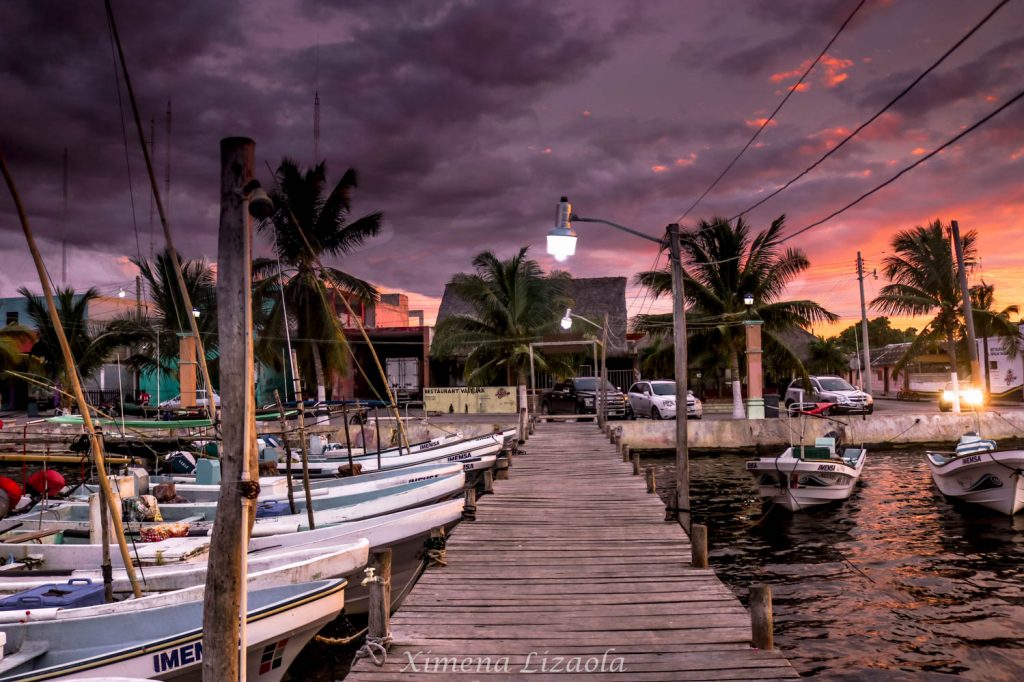What Are Coral Reefs?
Corals are organisms that develop successfully in tropical seas, they are the builders of the reef formed by sedentary colonies of hundreds or thousands of very delicate organisms called polyps, belonging to the animal kingdom, and are associated in symbiosis with the presence of an alga called Zooxanthella, which lives inside the polyp tissue and is essential for the production of oxygen, and the release of carbon dioxide, among other elements.
Thanks to this symbiosis (Figure 1), the polyps can build large calcium carbon skeletons to give structure to the reef and provide a safe and predator-free environment for the zooxanthellae, except under stressful conditions where the algae can be expelled from the polyp and because the zooxanthellae provide the diversity of colors and pigments to the corals, it results in coral bleaching, however, together they collaborate with other organisms to provide nutrients essential for their growth.

Figure 1. Coral symbiosis, Zooxanthellae. Far-Reaching Ecological Systems
https://www.behance.net/gallery/4040147/Far-Reacing-Ecological-Systems.
Within the way of life of corals, food can be obtained from suspended particles, bacteria, and organic compounds diluted in the water. On the other hand, the reproduction of these organisms is very varied, they can reproduce continuously or only in one season and there are two types of reproduction: sexual reproduction consists of the fertilization of gametes either internally or externally, there is genetic variability and in some species, the sexes may be separated known as gonochoric or if they have both sexes they are hermaphrodites, and the other type of reproduction is asexual, by fragmentation, in this type of reproduction there is no genetic variability, and it is a strategy to increase the number of colonies in an area by simple division of polyps (Photo 1) for the growth of genetically identical individuals.
During their development, corals deposit a skeleton that adds to the construction of the reef, this skeleton is lifeless so the surface of the reef is the living part that maintains the colonies, in these formations, there are different forms of life of animals and algae, such as mollusks, sponges, coralline algae, tubeworms, fish, among other non-reef building corals, such as fire coral, gorgonians and soft corals, and being the dominant element for all the diversity, this type of ecosystem is called reef systems.
Regarding the growth rate of corals, it is estimated between 1 to 10 cm per year depending on the different species, there are some that are slow-growing and others that are fast-growing such as branching species, which give more roughness and structure to the reef system, despite these small measures, it is impressive the formation of these structures of the reef systems of the world through time, they are undoubtedly the most ancient communities of the sea, with a geological history of more than 500 million years.

Photo 1. Colony of polyps of Orbicella annularis, the coloration of the corals is due to the zooxanthellae responsible for pigmentation. Photo: Ximena Lizaola
And that's not all coral reefs are! they are also geographic barriers that protect the coastal zone and rainforest, buffering and dissipating the energy of tropical storms and hurricanes to avoid high-level natural catastrophes, protect hundreds of animals, and are the refuge of many species of fish, which attracts one of the most important predators in the ocean, All these energies flow provide environmental services for developing communities (Photo 2) through tourism and fishing, are an important financial source for humans and a natural resource necessary for the functioning of the ecosystem.
However, for several decades this symbiosis has been in a fragile balance that is affected by various factors of climate change, such as high elevations in temperature and acidification, causing coral bleaching until its death, and on the other hand, anthropocentric activities such as mangrove deforestation, pollution, strandings, oil spills, sewage discharge, among others, anthropocentric activities such as mangrove deforestation, pollution, strandings, oil spills, sewage discharge, among others, causing serious diseases that can kill the colonies and eventually the surface layer of the reef leaving only the calcareous skeleton of the coral. The current loss of coral reefs has drawn attention in different parts of the world, their growth is no longer sufficient to compensate for the loss caused by human misuse of natural resources.
For these reasons, it is important to know the reef builders, their problems, and the solutions of different organizations, institutions, and the participation of the communities for the restoration of these colonies so important for humans and nature.

Photo 2. Coral reefs provide environmental services and support the local economy of the communities.


